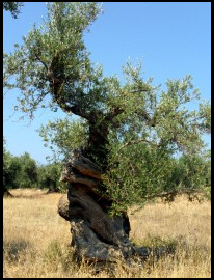
Interesting Olive Oil Facts
The olive tree, Olea europaea, is an evergreen tree or shrub native to the Mediterranean, Asia and Africa. It is short and squat, and rarely exceeds 8–15 metres (26–49 ft) in height.
The olive tree is very hardy. It is drought-, disease- and fire-resistant and can live to a great age. Its root system is robust and capable of regenerating the tree even if the above-ground structure is destroyed. The older the olive tree, the broader and more gnarled the trunk becomes.
Many olive trees in the groves around the Mediterranean are said to be hundreds of years old, while an age of 2,000 years is claimed for a number of individual trees; in some cases, this has been scientifically verified.

There are thousands of cultivars of the Olea europaea olive tree. The Koroneiki cultivar orginated in the southern Peloponnese, around Kalamata and Mani in Greece. This small olive, though difficult to cultivate, has a high yield of olive oil of exceptional quality.
Trees in the area around Kyparissia and Christianoupolis, where The Olive Table extra virgin olive oils come from, range in age from young trees to more than 300 years old.
There is only one harvest and one pressing per year.
 The olive harvest normally takes place in late November and December. Harvesting is generally done when the olives are at their peak to preserve the quality and low acidity levels of the resulting oil. Olives that are too ripe produce more oil but of lesser quality.
The olive harvest normally takes place in late November and December. Harvesting is generally done when the olives are at their peak to preserve the quality and low acidity levels of the resulting oil. Olives that are too ripe produce more oil but of lesser quality.
‘Early Harvest’ takes place in mid to late October. Early harvest olives are considered three quarters ripe and produce greener oil due to the higher level of chlorophyll in the olives. The resulting oil is exceptionally high in antioxidants and polyphenols.
In Greece, early harvest oil is known as ‘agoureleo’ and is considered the best and healthiest olive oil produced.
It takes approximately 5 to 8 years for an olive tree to bear its first fruit.
Large olive trees produce, on average, 3 to 4 100-lb sacks of olives. Older and larger trees can produce more.
Each 100-lb sack produces, on average, only between 7.5 and 10.5 liters of oil. The earlier the olives are harvested, the less oil will be produced.
Now that you have the Facts, it’s time to talk about Taste! Go to Our Olive Oil page to read about The Olive Table’s Extra Virgin Olive Oils or go to Products to start shopping now!


